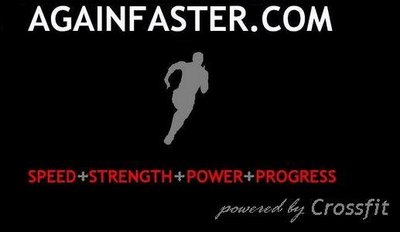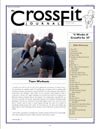Variability and Randomness

Crossfit programming is "constantly varied". The immense variety of workouts is meant to prevent stagnation by continually imposing new stressors onto the athlete. This process ensures that the athlete is in a constant state of inadequate adaptation. The workouts never become rote.
The workout template has been quantified in general terms in the Crossfit Journal (March 2004). The three day cycle consists of:
A day of "blistering intensity"
A focus day
A day of "blistering intensity"
Within this template, you can impose endless variation. You can also willfully ignore the template for the sake of further variation. I'm going to focus on this second form of variation.
Imagine a very large jar filled with marbles, each marble representing a unique workout. We draw a marble from the jar each day, determining the WOD. Assume that each marble has an equal chance of being selected, regardless of its place within the jar. If we select a marble each day, and then replace it, there is a chance (however slight) that we may select it again on a successive draw. Using this model, there is a chance that we could end up doing the same workout two days in a row.
Using the traditional Crossfit template, this could not happen. We have two separate jars--the "intensity" jar and the "focus" jar. Because we draw from different jars on different days, we cannot get the same workout twice.
Chad Waterbury, a trainer at T-nation, makes an interesting point regarding repetition of the same exercise on successive days. He notes that in an untrained population, those with the most hypertrophy of a given bodypart are those who use that bodypart every day. Mechanics have big forearms, lumberjacks have broad backs, and basketball players have huge calves.
Of course, we already know that we can induce muscle growth by working the same muscle group on successive days. We often explain our distain for bodypart splits by saying that life does not care what you did yesterday. It may make you use the same muscles to do the same thing today.
Does this idea extend to the constant variability of Crossfit? Should we distain a switch between "intensity" and "focus" the way we distain bodypart splits? Can we shock our bodies into greater speed and strength by working the same muscle group in the same way two days in a row?
Randomness, as demonstrated by our marble model, would predict that this scenario would occur sooner or later. Eventually, chaos dictates we do the same workout two days in a row. The idea of variation through lack of variation is counter-intuitive, but nonetheless valid.
I'm going to try this out. It could be totally insane, or mildly revolutionary. Then again, I've found that everything worth doing is usually one or the other.

Crossfit programming is "constantly varied". The immense variety of workouts is meant to prevent stagnation by continually imposing new stressors onto the athlete. This process ensures that the athlete is in a constant state of inadequate adaptation. The workouts never become rote.
The workout template has been quantified in general terms in the Crossfit Journal (March 2004). The three day cycle consists of:
A day of "blistering intensity"
A focus day
A day of "blistering intensity"
Within this template, you can impose endless variation. You can also willfully ignore the template for the sake of further variation. I'm going to focus on this second form of variation.
Imagine a very large jar filled with marbles, each marble representing a unique workout. We draw a marble from the jar each day, determining the WOD. Assume that each marble has an equal chance of being selected, regardless of its place within the jar. If we select a marble each day, and then replace it, there is a chance (however slight) that we may select it again on a successive draw. Using this model, there is a chance that we could end up doing the same workout two days in a row.
Using the traditional Crossfit template, this could not happen. We have two separate jars--the "intensity" jar and the "focus" jar. Because we draw from different jars on different days, we cannot get the same workout twice.
Chad Waterbury, a trainer at T-nation, makes an interesting point regarding repetition of the same exercise on successive days. He notes that in an untrained population, those with the most hypertrophy of a given bodypart are those who use that bodypart every day. Mechanics have big forearms, lumberjacks have broad backs, and basketball players have huge calves.
Of course, we already know that we can induce muscle growth by working the same muscle group on successive days. We often explain our distain for bodypart splits by saying that life does not care what you did yesterday. It may make you use the same muscles to do the same thing today.
Does this idea extend to the constant variability of Crossfit? Should we distain a switch between "intensity" and "focus" the way we distain bodypart splits? Can we shock our bodies into greater speed and strength by working the same muscle group in the same way two days in a row?
Randomness, as demonstrated by our marble model, would predict that this scenario would occur sooner or later. Eventually, chaos dictates we do the same workout two days in a row. The idea of variation through lack of variation is counter-intuitive, but nonetheless valid.
I'm going to try this out. It could be totally insane, or mildly revolutionary. Then again, I've found that everything worth doing is usually one or the other.




















4 Comments:
Jon, I suggest you actually conduct a practical test and arrange a long-term schedule based on your marble jar. It would be interesting to see whether randomly chosen exercises would provide the same balance of stimulation as those chosen by an instructor. It's all in the math. Results might actually indicate whether Crossfit workouts subconsciously over-emphasize certain muscle groups.
This is an interesting idea. I can't conduct it in real life--as a member of Crossfit Boston, my workouts mirror Neal's programming 3 days a week, and my programming the other 2 or 3. At least half the workouts would not follow the marble jar model.
I could model this in Excel, but it would require a huge data dump. I'd have to input every workout, and subjectively determine the main muscle group and pathway it works. There could be some disagreement there. I'd also need to have a huge history of programming (no problem).
The main problem I see comes in the term "overemphasis". This is highly related to recovery and subsequent ability to workout with intensity. Overemphasis for me might not be overemphasis for you.
Check out my post on "Thinking about Training" near the beginning of May. I'm using the quantitative model presented there to determine when and where overemphasis occurs in my programming.
I think the Crossfit model, as it stands, consciously avoids overemphasis by changing up the emphasized metabolic pathway. This allows sustained intensity across the 3-day cycle.
The question I bring up in my post, in my mind, is whether or not this concious avoidance of overemphasis mirrors real life, and if not, could an occassional foray into overemphasis actually be beneficial.
I hesitate to draw conclusions based on my experiences alone, but I'm going to give this a shot. I might burn out. I might not. I'll record the numbers on recovery, difficulty, and intensity as I outlined in "Thinking about Training".
If I've built sufficient work capacity, doing the same workout two days in a row may shock me into growth. If I haven't, it might kill me.
The idea is that this two-workout pattern be used only very occassionally--otherwise, we'd just be back to the stage where we did the same damn workout every day at Bally's. I'm not going back there--it's scary.
I think what you wrote today and on Monday ties together. You're basically talking about the ideal fitness routine for the ideal person capable of performing pretty much any physical task. A balanced schedule should give you that all-round fitness. Of course you'd have to quantify a good cross section of different tasks. Maybe you'd discover that in general physical tasks require more upper arm strength than abdominal strength, and this in turn would influence the overall effect you'd want to achieve with Crossfit. On the other hand, you could just sit back, say "screw this shit", grab a beer and get a life. KISS :)
Toby
That was the impersonal "you", BTW. As in "one could just sit back..."
Anyhow, we need to get out more :-\
Post a Comment
<< Home